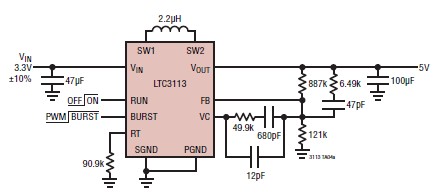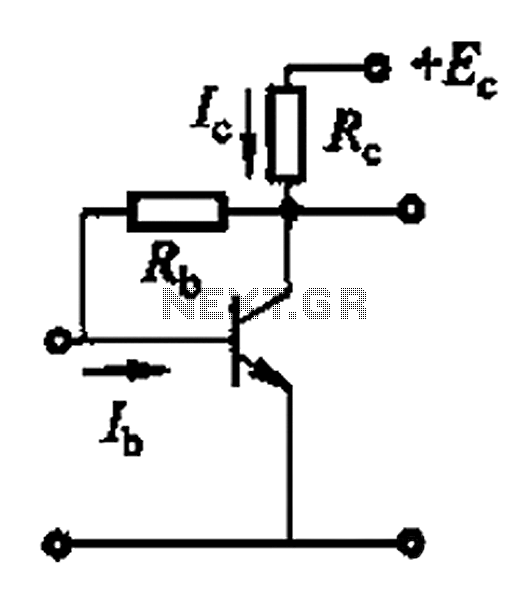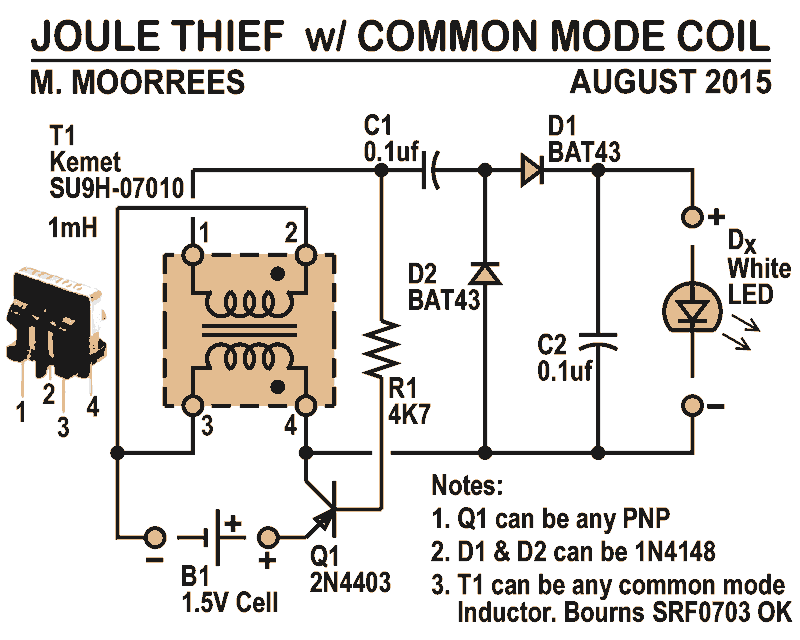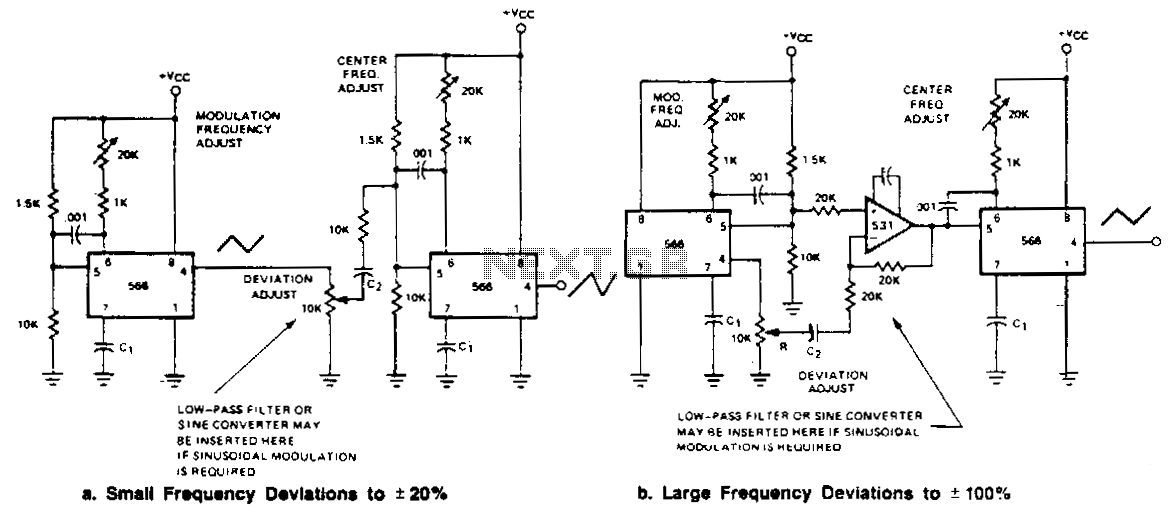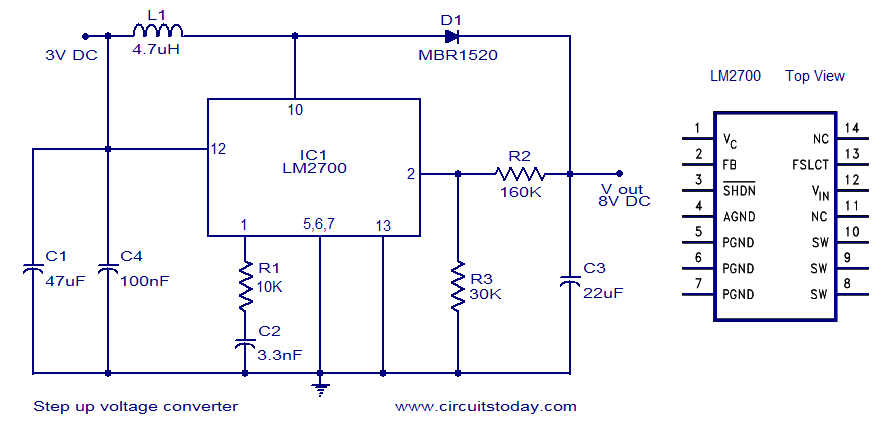
voltage frequency converter
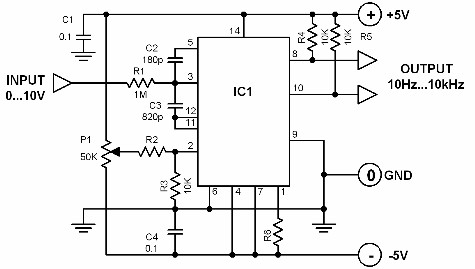
A voltage-to-frequency converter with a control range of 1:1000 can be constructed using the IC TSC9402. The specified component values in the circuit yield a conversion factor of 1 kHz per 1 V. Input voltages ranging from 10 mV to 10 V are converted to frequencies from 10 Hz to 10 kHz. This conversion can be adjusted through the potentiometer P1. The circuit features two outputs: a sharp pulse from pin 8 with the main output frequency, and a clean square wave from pin 10, which has a frequency that is half of the output frequency at pin 8. Calibration is performed using an accurate frequency counter, adjusting P1 so that an input level of 10 mV produces a 10 Hz output signal. One application for this circuit is in telemetry, specifically for transmitting voltage values. By converting voltage values to frequency, the data can be transmitted via coaxial cable or radio. The wireless telemetry method can be achieved by using the output of this circuit to modulate the carrier signal of a transmitter. Direct use of the output frequency is limited, as it reaches a maximum of 10 kHz (corresponding to a 10 V input). The accompanying diagram illustrates the circuit's use for remote measurements via coaxial cable, though the technique is limited to a few meters. Signal amplification can extend this distance. Additionally, the diagram shows the circuit modulating a transmitter to send measured values through radio signals, allowing for remote telemetry over extensive distances. If the signal is relayed via a satellite transponder, global telemetry is achievable.
A voltage-to-frequency converter utilizing the TSC9402 IC is designed to achieve a significant control range of 1:1000, facilitating the conversion of varying input voltages into corresponding frequency outputs. The circuit operates effectively within the input voltage range of 10 mV to 10 V, translating these values into frequency outputs that span from 10 Hz to 10 kHz. This conversion is primarily determined by the component values selected in the circuit, ensuring a conversion factor of 1 kHz for every volt applied.
The circuit's configuration includes a potentiometer, P1, which allows for fine-tuning of the conversion characteristics to meet specific application requirements. The two output signals generated by the circuit cater to different needs: pin 8 outputs a sharp pulse representing the main output frequency, while pin 10 provides a clean square wave at half the frequency of the signal from pin 8. This dual output capability enhances the circuit's versatility in various applications.
Calibration of the circuit is critical for accurate operation. This is achieved by employing a precise frequency counter to adjust the potentiometer P1, ensuring that an input voltage of 10 mV corresponds to a 10 Hz output frequency. This calibration step is essential for applications where precise frequency outputs are required, such as in telemetry systems.
In telemetry applications, the voltage-to-frequency conversion is particularly beneficial for transmitting voltage measurements over distances. The converted frequency can be transmitted through coaxial cables or utilized in wireless telemetry systems. The output from the converter can modulate a carrier signal in a transmitter, allowing for radio frequency transmission of the measured data. However, it is important to note that the maximum output frequency is limited to 10 kHz, which corresponds to a maximum input voltage of 10 V.
For remote measurements using coaxial cables, a diagram illustrates the configuration, emphasizing that while effective, the technique is limited to short distances, typically a few meters. To overcome this limitation, a signal amplifier can be integrated to extend the transmission range. Furthermore, the circuit can be adapted for radio transmission, where the modulated signal can be transmitted over longer distances. Utilizing satellite transponders for signal relaying can facilitate global telemetry capabilities, enabling the collection and transmission of data from remote locations worldwide.A voltage to frequency converter with a control range of 1:1000 can be easily constructed by using the IC TSC9402. The given component values in the circuit produces a conversion factor of 1kHz/1V. The input voltages from 10 mV up to 10 V are converted to frequencies 10 Hz up to 10 kHz. This conversion can be changed if desired through the potenti ometer P1. The circuit has two outputs: a sharp pulse comes out from pin 8 with the main output frequency. A clean squarewave comes out of pin 10 but its frequency is half of the output frequency at pin 8. Calibration: use an accurate frequency counter and adjust P1 so that an input level of 10 mV will produce a signal of 10 Hz at the output. One area of application for this circuit is the telemetry. In this case, telemetry of voltage values. By converting the voltage value to a frequency, the value can be transmitted either via a coaxial cable or radio.
Wireless telemetry method using radio, can be realized by using the output of this circuit to modulate the carrier signal of a transmitter. It is not possible to use directly the output frequency of this circuit since it produces only a maximum of 10 kHz (equivalent to a measured voltage of 10 volts at its input).
The following diagram shows how to use the circuit for remote measurements using a coaxial cable. The technique is limited to several meters though. The distance can be increased by using a signal amplifier. The diagram on the right shows the circuit modulating a transmitter to transport the measured value via radio signals. This technique allows remote telemetry over very long distances. If the signal is repeated via a satellite transponder, the telemetry can be done worldwide. 🔗 External reference
A voltage-to-frequency converter utilizing the TSC9402 IC is designed to achieve a significant control range of 1:1000, facilitating the conversion of varying input voltages into corresponding frequency outputs. The circuit operates effectively within the input voltage range of 10 mV to 10 V, translating these values into frequency outputs that span from 10 Hz to 10 kHz. This conversion is primarily determined by the component values selected in the circuit, ensuring a conversion factor of 1 kHz for every volt applied.
The circuit's configuration includes a potentiometer, P1, which allows for fine-tuning of the conversion characteristics to meet specific application requirements. The two output signals generated by the circuit cater to different needs: pin 8 outputs a sharp pulse representing the main output frequency, while pin 10 provides a clean square wave at half the frequency of the signal from pin 8. This dual output capability enhances the circuit's versatility in various applications.
Calibration of the circuit is critical for accurate operation. This is achieved by employing a precise frequency counter to adjust the potentiometer P1, ensuring that an input voltage of 10 mV corresponds to a 10 Hz output frequency. This calibration step is essential for applications where precise frequency outputs are required, such as in telemetry systems.
In telemetry applications, the voltage-to-frequency conversion is particularly beneficial for transmitting voltage measurements over distances. The converted frequency can be transmitted through coaxial cables or utilized in wireless telemetry systems. The output from the converter can modulate a carrier signal in a transmitter, allowing for radio frequency transmission of the measured data. However, it is important to note that the maximum output frequency is limited to 10 kHz, which corresponds to a maximum input voltage of 10 V.
For remote measurements using coaxial cables, a diagram illustrates the configuration, emphasizing that while effective, the technique is limited to short distances, typically a few meters. To overcome this limitation, a signal amplifier can be integrated to extend the transmission range. Furthermore, the circuit can be adapted for radio transmission, where the modulated signal can be transmitted over longer distances. Utilizing satellite transponders for signal relaying can facilitate global telemetry capabilities, enabling the collection and transmission of data from remote locations worldwide.A voltage to frequency converter with a control range of 1:1000 can be easily constructed by using the IC TSC9402. The given component values in the circuit produces a conversion factor of 1kHz/1V. The input voltages from 10 mV up to 10 V are converted to frequencies 10 Hz up to 10 kHz. This conversion can be changed if desired through the potenti ometer P1. The circuit has two outputs: a sharp pulse comes out from pin 8 with the main output frequency. A clean squarewave comes out of pin 10 but its frequency is half of the output frequency at pin 8. Calibration: use an accurate frequency counter and adjust P1 so that an input level of 10 mV will produce a signal of 10 Hz at the output. One area of application for this circuit is the telemetry. In this case, telemetry of voltage values. By converting the voltage value to a frequency, the value can be transmitted either via a coaxial cable or radio.
Wireless telemetry method using radio, can be realized by using the output of this circuit to modulate the carrier signal of a transmitter. It is not possible to use directly the output frequency of this circuit since it produces only a maximum of 10 kHz (equivalent to a measured voltage of 10 volts at its input).
The following diagram shows how to use the circuit for remote measurements using a coaxial cable. The technique is limited to several meters though. The distance can be increased by using a signal amplifier. The diagram on the right shows the circuit modulating a transmitter to transport the measured value via radio signals. This technique allows remote telemetry over very long distances. If the signal is repeated via a satellite transponder, the telemetry can be done worldwide. 🔗 External reference
